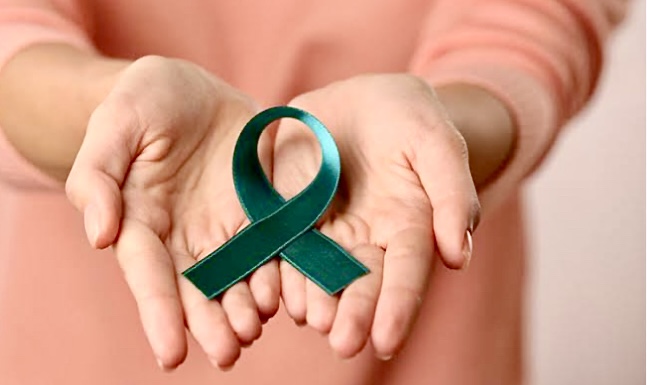By Dr DK Gupta
The cause of cervical cancer has just got attention after Poonam Pandey's ‘death' hoax yesterday. it serves as a poignant reminder of the urgency to address cervical cancer, a disease claiming many lives in India. This incident underscores the importance of understanding and combating this deadly illness, as highlighted by Finance Minister Nirmala Sitharaman's recent budget speech mentioning cervical cancer.
Understanding Cervical Cancer: Symptoms, Causes, and Prevention
Cervical cancer, one of the most prevalent cancers among women globally, originates from abnormal cell growth in the cervix, the lower part of the uterus connected to the vagina. The primary cause of cervical cancer is the Human Papillomavirus (HPV), a common virus transmitted through sexual contact. While most HPV infections resolve spontaneously, persistent infections can lead to the development of cervical cancer over time.
The government's recent announcement to provide free Cervical Cancer Vaccines for girls aged 9 to 14 is a groundbreaking initiative that comes at a critical juncture. Cervical cancer, ranking as the 4th leading cause of death worldwide, underscores the urgency and significance of preventive measures. This move not only addresses a concerning global health statistic but also reflects a proactive stance by the government to curb the impact of this formidable health challenge. By prioritizing vaccination for young girls, the initiative demonstrates a commitment to reducing the burden of cervical cancer and fostering a healthier future for the nation.
Cervical cancer originates from the growth of cells in the cervix, the lower part of the uterus connected to the vagina. Most cases of cervical cancer are linked to various strains of the human papillomavirus (HPV), a common infection transmitted through sexual contact. While the body's immune system can often combat HPV upon exposure, in a small percentage of individuals, the virus persists for an extended period, contributing to the development of cancerous cervical cells.

To minimize the risk of cervical cancer, individuals are advised to undergo screening tests and receive a vaccine designed to protect against HPV infection. In cases where cervical cancer is diagnosed, initial treatment typically involves surgery to remove the cancer. Additional treatment options may include medications to eliminate cancer cells, such as chemotherapy and targeted therapy. Radiation therapy, utilizing potent energy beams, may also be employed, sometimes in combination with low-dose chemotherapy.
Symptoms:
Cervical cancer may not initially exhibit noticeable symptoms. However, as the cancer progresses, individuals might experience signs such as:
1. Vaginal bleeding after intercourse, between menstrual periods, or post-menopause.
2. Menstrual bleeding that becomes unusually heavier and lasts for an extended duration.
3. Watery, bloody vaginal discharge, often accompanied by a strong and unpleasant odor.
4. Pelvic pain or discomfort, including pain during sexual intercourse.
Causes
Cervical cancer initiates when the DNA of healthy cells in the cervix undergoes alterations. DNA, functioning as a cell's instructional manual, directs its activities. These alterations prompt rapid cell multiplication, enabling them to persist beyond their natural life cycle, resulting in an excess of cells. This surplus might form a mass known as a tumor, capable of infiltrating and damaging surrounding healthy tissues. Over time, these cells can detach and metastasize to other areas of the body.
The predominant cause of cervical cancer is the Human Papillomavirus (HPV), a common virus transmitted through sexual contact. While many individuals naturally clear the virus without complications, some may experience changes in cells that elevate the risk of cancer.
Types of Cervical Cancer:
Cervical cancer manifests in various types, primarily categorized based on the cell where the cancer originates. Squamous cell carcinoma, the most prevalent type, originates in thin, flat squamous cells lining the cervix's outer part. Adenocarcinoma, on the other hand, begins in column-shaped gland cells lining the cervical canal. Occasionally, both cell types may be involved, and more rarely, cancer may develop in other cervical cells.
Risk Factors
Risk factors associated with cervical cancer comprise:
1.Tobacco Smoking: Engaging in tobacco smoking elevates the likelihood of cervical cancer. In individuals who smoke and contract HPV infections, these infections tend to persist for longer durations and are less likely to resolve. Notably, HPV is a primary contributor to most cervical cancers.
2. Multiple Sexual Partners: An increased number of sexual partners, both for you and your partner, heightens the probability of acquiring HPV. The more extensive the sexual network, the greater the potential for HPV transmission.
3. Early Initiation of Sexual Activity: Commencing sexual activity at a young age enhances the risk of contracting HPV. Early sexual engagement contributes to an increased vulnerability to the virus.
4. Other Sexually Transmitted Infections (STIs): The presence of additional STIs amplifies the risk of HPV infection, consequently heightening the risk of developing cervical cancer. STIs such as herpes, chlamydia, gonorrhea, syphilis, and HIV/AIDS are known to increase this risk.
5. Weakened Immune System: Individuals with compromised immune systems due to other health conditions face an augmented likelihood of developing cervical cancer when infected with HPV.
6. Exposure to Miscarriage Prevention Medicine: Exposure to diethylstilbestrol (DES), a medication utilized in the 1950s to prevent miscarriages, heightens the risk of cervical cancer.
Understanding these risk factors is crucial for implementing preventive measures and promoting early detection.
Prevention
To mitigate the risk, individuals are advised to consider preventive measures:
1. HPV Vaccination: Inquire with your doctor about receiving the HPV vaccine to reduce the risk of cervical cancer and other HPV-related cancers.
2. Routine Pap Tests: Regular Pap tests are crucial for detecting precancerous conditions early, allowing for monitoring or treatment to prevent cervical cancer. Initiate routine Pap tests at age 21 and repeat them periodically.
3. Safe Sex Practices: Employ safe sex practices, such as using condoms consistently and limiting the number of sexual partners, to reduce the risk of sexually transmitted infections.
4. Tobacco Avoidance: Steer clear of smoking, and if you currently smoke, consult with a healthcare professional for guidance on quitting.
5. Adopting a nutritious diet: Prioritize fruits and vegetables: Build your diet around fruits, vegetables, and plant-based foods like whole grains and beans. Opt for lighter and leaner choices, minimizing the intake of high-calorie foods. Restrict the consumption of refined sugars and fats from animal sources.
6. Moderate alcohol consumption: If you choose to drink alcohol, do so in moderation or consider abstaining altogether. Excessive alcohol intake elevates the risk of various cancers, including those affecting the breast, colon, lung, kidney, and liver.
The writer is Chairman, Felix Hospital, Noida

The BuckStopper, run by a group of seasoned journalists, holds the powerful accountable. The buck stops with them, as they cannot shrug off their official responsibilities.



